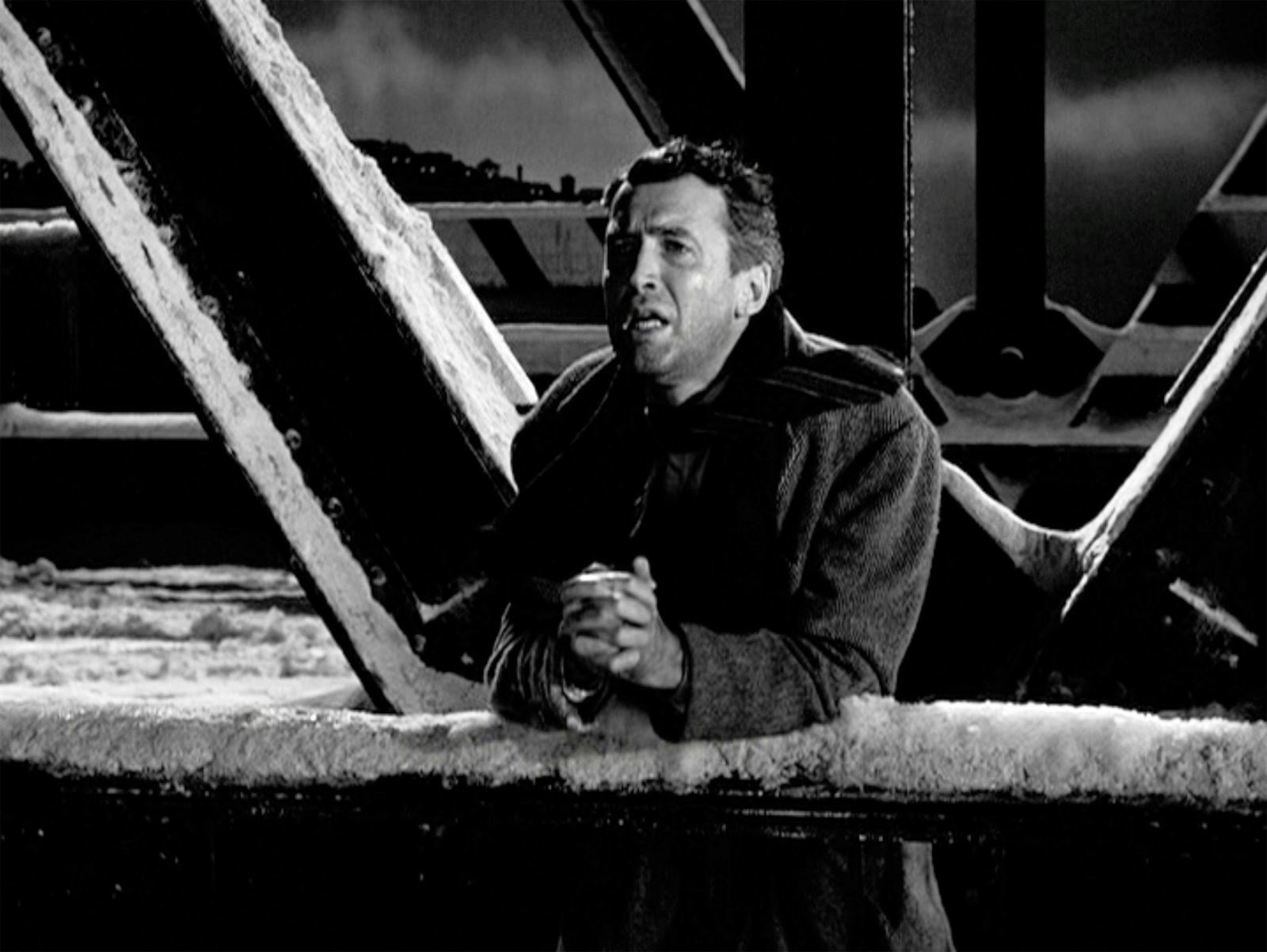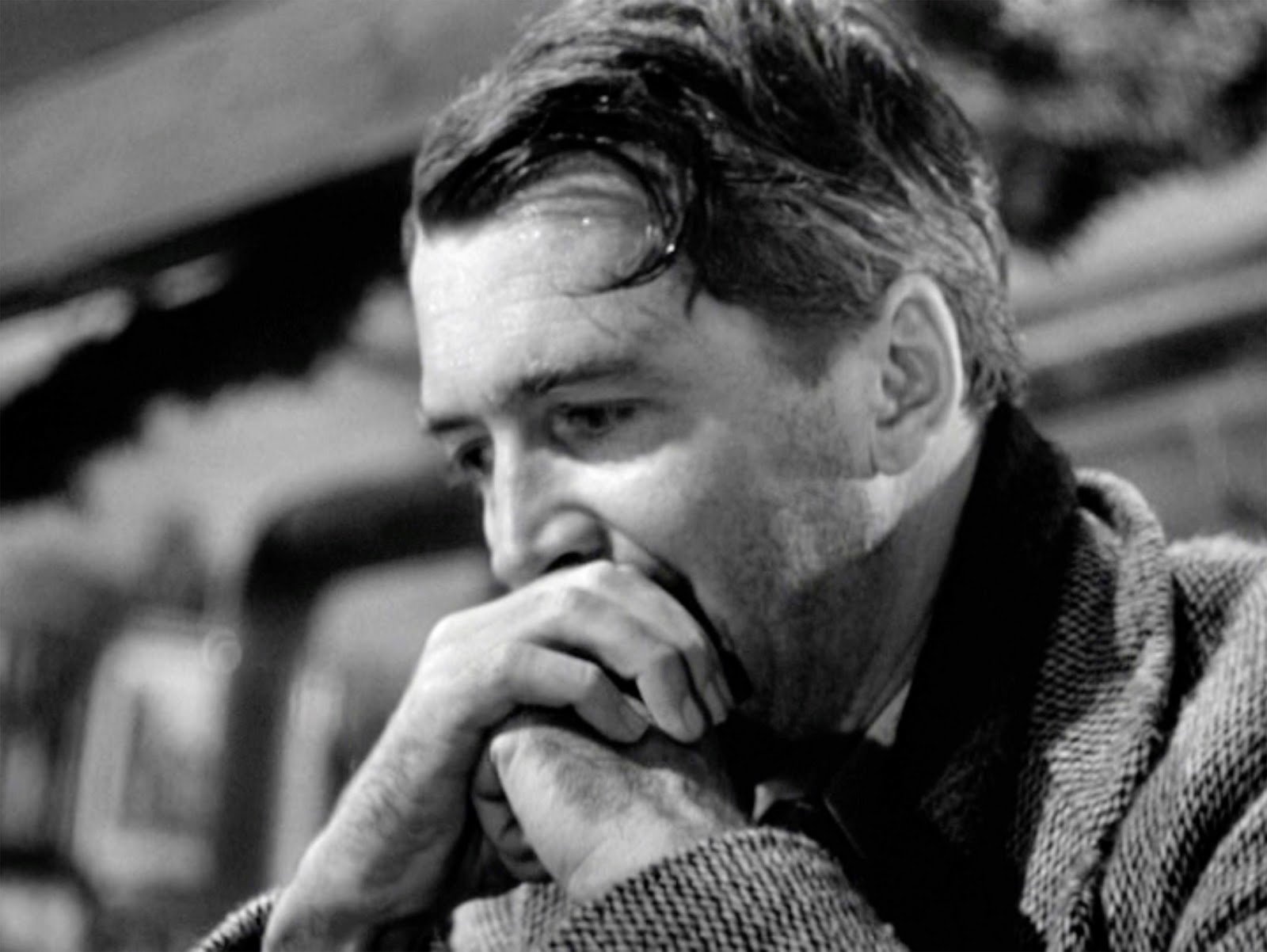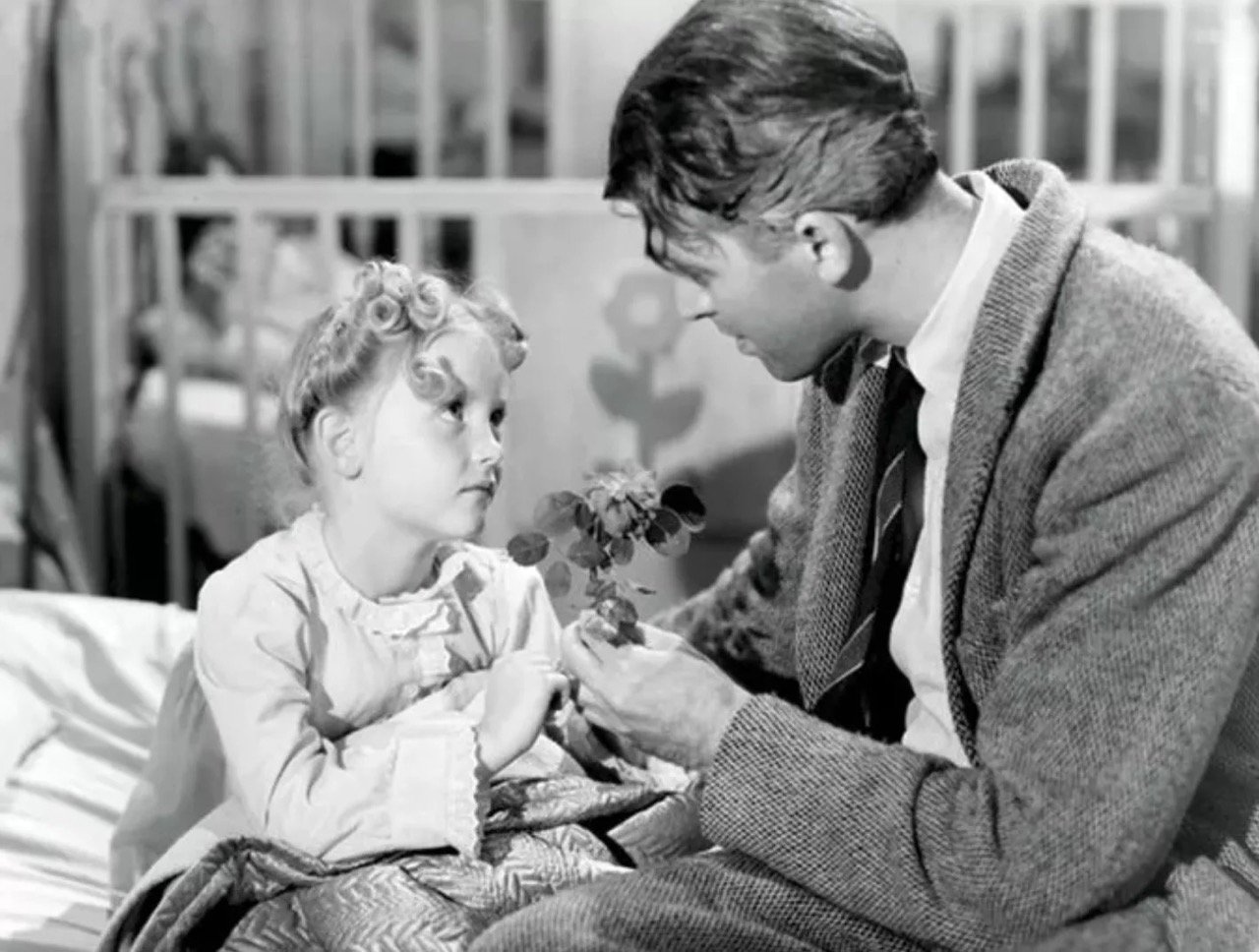5 Things “It’s A Wonderful Life” Can Teach Us About Preventing Suicide by Ilana Jael
It’s a Wonderful Life (1946)
Though there is plenty of cheer and humor in our production of It’s A Wonderful Life, it’s important not to forget that the play also touches on some incredibly sensitive subject matter: when we first meet our protagonist, he is seriously considering suicide. And though it may be difficult for some who have never experienced suicidal ideation to imagine how an otherwise rational person may be driven to such an extreme act, George Bailey is far from alone in having considered ending things when his life’s painful circumstances came to exceed his capacity to cope.
Though an enormous stigma still surrounds suicidality, the CDC reports that an estimated 12.2 million American adults thought seriously about suicide in the year 2020. Of those, 3.2 million went on to plan an attempt, and 1.2 million went on to make one. Also in 2020, nearly 46,000 people died by suicide, making it one of the top 9 leading causes of death for people ages 10-64 and resulting in one death every 11 minutes.
While these numbers may sound bleak, there is a bright side to these statistics in that over 90 percent of people who attempt suicide never go on to die of it, suggesting that the vast majority of suicide deaths may in fact be preventable. Thus, using the familiar story of It’s A Wonderful Life to explore some of what everyone can keep in mind when it comes to preventing suicide seems like a decent way to impart some incredibly important information—and maybe even to someday save a life.
1. How to Recognize Key Risk Factors And Warning Signs
Before we can consider what steps we might take to help someone whom we fear may be experiencing a suicidal crisis, we might first consider how to recognize that someone in our life may be at risk. Though a more detailed list of risk factors, protective factors, and warning signs can be found at this page from the American Foundation for Suicide Prevention, one of the biggest things to keep in mind is that those who struggle with mental health conditions are uniquely vulnerable.
However, somewhat more surprisingly, research also suggests that 54 percent of people who die of suicide are those who had no known mental health issues at all. This may be because there are also a variety of environmental factors that can heighten a person’s acute risk of dying via suicide, the first three of which are clearly relevant to George Bailey’s case and the fourth of which I’ll get back to later:
“Access to lethal means including firearms and drugs
Prolonged stress, such as harassment, bullying, relationship problems or unemployment
Stressful life events, like rejection, divorce, financial crisis, other life transitions or loss
Exposure to another person’s suicide, or to graphic or sensationalized accounts of suicide”
Those who have a family history of suicide, a history of prior attempts, or a history of trauma or abuse are also at significantly higher risk. Then, there are demographic risk factors to consider, some of which you can find listed here. One of these, while not being applicable to George Bailey himself, is also interesting to consider when it comes to the way the character was portrayed in It’s A Wonderful Life’s original film version: having spent time in the military.
As described in this article, actor Jimmy Stewart was not terribly far out from his stint in service as a World War II fighter pilot when the movie was made, and grappled with significant symptoms of post-traumatic stress disorder throughout the process. Thus, the desperation visible in Stewart’s performance is not only evidence of an incredible actor at work but an important reminder of the unique mental health challenges returning veterans routinely face.
Then, there’s the matter of warning signs. One method that the American Association of Suicidology put forth to help people remember some key signs someone may be suicidal is a mnemonic known as IS PATH WARM?, an acronym representing the list described below:
“Ideation—Threatened or communicated
Substance abuse—Excessive or increased
Purposeless—No reasons for living
Anxiety—Agitation/Insomnia
Trapped—Feeling there is no way out
Hopelessness
Withdrawing—From friends, family, society
Anger (uncontrolled)—Rage, seeking revenge
Recklessness—Risky acts, unthinking
Mood changes (dramatic)”
It’s a Wonderful Life (1946)
And if we take It’s A Wonderful Life as a case study, we can find that the film arguably provides examples of pretty much every attribute listed in its portrayal of George Bailey’s experience. After he finds out that Uncle Billy has misplaced a large amount of money, we see dramatic mood changes in the usually good-tempered Bailey, as he erupts in anger at his family and expresses how trapped he feels in his drafty house and parental obligations. He proceeds to recklessly pick up the phone so he can scream at his child’s teacher, and then to inexplicably withdraw from his loved ones in a clearly agitated state before proceeding to get far more intoxicated than usual at the local bar (increased substance abuse).
He then expresses hopelessness in a desperate prayer as he contemplates how purposeless his life would become should he fail to save his family business, and it’s then that he clearly expresses ideation by wishing he hadn’t been born. Perhaps laying all that out was only explaining the obvious, but, then again, perhaps you’ll find it easier to remember what IS PATH WARM stands for if you can connect it to George Bailey’s travails.
Some other things to be on the lookout for include anything that hints, even obliquely, that a person doesn’t intend to be around much longer. Though there may be a perfectly innocent explanation, people who plan on killing themselves may also take telltale actions like giving away prized possessions, getting their affairs in order, or engaging in uncharacteristically risky behaviors because they believe they will not be around to reap the consequences. Paradoxically, a suicidal person who has decided that they intend to die may also appear unusually calm relative to their previous mentality—because they have emotionally absolved themselves of their problems by making plans to end their life. As I describe in more detail in point number four, if any uncertainty presents itself, the best thing to do is to just to ask.
2. Suicidal Feelings Are Usually Temporary, But Ensuring Safety In The Moment Is Critical
One of the many criticisms that It’s A Wonderful Life has faced over the years has come from those who find it unrealistic that a man could be bursting with Christmas cheer less than an hour after he nearly jumps to his death. But while there are many people who struggle with chronic suicidal ideation, research also suggests that most suicidal crises are indeed fairly short-lived. This is especially true for people without any known mental health issues who were simply pushed over the edge by temporary stressors, which is what seems to have been the case with George. More than half of people who survive a suicide attempt or are stopped from making one never try again, and, as I mentioned earlier, only one in ten will ever go on to die of it.
Yet, as heartening as that fact is, the chilling flip side of how temporary suicidal feelings can be is how quickly they can spiral into irreversible tragedy. According to this look at the research, 24 percent of people who attempted suicide deliberated for less than five minutes before making an attempt, and another 24 percent deliberated for less than 20 minutes. Only 13 percent thought about it for any longer than a day.
One takeaway from this is that though any suicidal person has every possibility of being able to rediscover the joy in their own wonderful life, the intensity of the pain they are experiencing in the moment could easily rob them of the chance. Practically, this means that if you believe someone may be thinking seriously of suicide, one of the most critical actions you can take is to ensure that they cannot physically harm themselves before they can receive help. Thus, you should make every effort to remove anything that could be deadly (firearms, knives, poisons, medications, ropes, etc) from the premises, and, if possible, you should not give the person an opportunity to act on thoughts of suicide by leaving them alone.
If the person continues to express suicidal intent or display emotional volatility, and/or if you are unable to ensure their physical safety, it may become necessary to seek professional help even if it goes against their in-the-moment wishes. If you have understandable reservations about calling 911, you also have the option of calling the National Suicide Prevention Lifeline at 988, which will connect you with trained counselors who can help you assess the situation and refer you to any appropriate resources, including emergency services.
As United Way suicide prevention coordinator Rick Wolfer spoke about in more detail at our recent Forum on Mental Health, you can also dial 211 for information about these potentially life-saving resources in Broward County and in many other areas of the US. Another thing Wolfer made a point of highlighting is the unique danger posed by firearms, which make it incredibly easy to quickly act on a suicidal impulse while also being incredibly lethal, resulting in death 85 to 90 percent of the time they are used in a suicide attempt.
Because of this, guns are the method responsible for a full half of all American suicide deaths, with a firearm suicide occurring approximately every 22 minutes. Thus, something as simple as keeping any guns in your home secured with a cable lock or in a locked safe could play a pivotal role in ensuring that those in your life are kept safe from suicide.
3. Asking For Help Is Always Better Than The Alternative
Moments before George meets Clarence on that fateful Bedford Falls bridge, we hear him deliver this desperate prayer:
God... God... Dear Father in Heaven, I'm not a praying man, but if you're up there and you can hear me, show me the way. I'm at the end of my rope. Show me the way, God.
It’s a Wonderful Life (1946)
And though the specific nature of his plea and of what happens afterward may be less applicable to the real-world issue of suicide, I do think George sets a powerful example in being willing to admit, even just to the heavens, that he had been pushed beyond his capacity to endure. And while he’s unusually lucky in that having the humility to ask for guidance is enough to summon an intervening angel, it’s worth noting that there are countless people in Bedford Falls he could have chosen to confide in instead. After all, given that the film’s conclusion shows that almost everyone in George’s life was eager to lend a hand when it became clear he was in trouble, it’s hard to imagine a confession of suicidal feelings being greeted with anything but a similar compassion.
On a related note: though the alternate universe George visits is one in which he had never been born rather than one in which he dies of suicide, it isn’t hard to imagine a similar story in which his family, friends, and neighbors are all worse off after he disappears. After all, the devastating impact of choosing not to ask for help is also crystal clear from the many heartbreaking accounts of those who have lost loved ones to suicide.
According to the American Foundation of Suicide Prevention, suicide loss is known to be particularly painful, even relative to other forms of grief. This is because survivors must grapple not only with the loss of their loved one but with feelings of guilt for failing to prevent the death, and often experience difficulty talking about their loss with others due to the shame and stigma that surround the issue.
While researching the history of It’s A Wonderful Life, I also found evidence of this particular principle in a relatively unexpected place: in a remark from actress Karolyn Grimes, who played George’s daughter Zuzu and later lost a son to suicide. In one interview, she describes:
“For a parent to lose a child in that way… it’s much worse than a car accident or any other kind of death because there’s so much guilt that goes with it. Your child was in so much pain they didn’t want to live any more. That’s a horrible thing to have to live with. You look back and think, why didn’t I? What if…?”
Karolyn Grimes as “Zuzu” It’s a Wonderful Life (1946)
Karolyn Grimes today
Though I also don’t want to imply that those who lose their lives to suicide should be blamed for not having the fortitude to imagine another path, it seems obvious that the vast majority of suicide survivors would have far rather assisted their loved ones in seeking help than had to face the aftermath of their lonely struggle.
And, if that weren’t enough, there are also plenty of accounts attesting to the aforementioned idea that most people who survive suicide attempts or resist suicidal feelings ultimately find themselves grateful to have been given a second chance. This article about people who have survived after jumping off the Golden Gate Bridge includes an account from one such survivor, which is both poignant and chilling:
The moment Ken Baldwin let go of the railing he immediately thought, “What am I doing? This was the worst thing I could do in my life.” He instantly thought of his wife and daughter and didn’t want to die. He recalls realizing that everything he thought was unfixable was totally fixable — except for having just jumped.
It’s haunting to imagine how many other jumpers might have had just such a thought but no opportunity to rectify their decision, or to imagine the countless loved ones such jumpers have left behind. Another point Wolfer raised is that each instance of suicide may impact as many as 135 other people— or, as only Clarence could articulate it:
Strange, isn't it? Each man's life touches so many other lives, and when he isn't around, he leaves a pretty big hole, doesn't he?
4. Never Be Afraid To Start a Hard Conversation
So, now that you hopefully have at least a vague idea how to recognize the signs someone may be suicidal, another question may present itself. If you do suspect that someone in your life is suicidal but they have not clearly told you so: well, then what? Is it enough to simply watch closely and wait for further signs of trouble— or is it OK to approach them and ask if everything is OK?
Well, at least according to the expert opinion that informed the 988-sponsored resource site Bethe1To: yes, you should go ahead and reach out. In fact, though the conversation that ensues could be difficult, you should also feel empowered to directly ask anyone you are worried about whether they are thinking of killing themselves, which is the first of five specific action steps that the site suggests.
This is because, though some erroneously believe that raising the subject of suicide could give an at-risk person a dangerous “idea,” research actually suggests that the opposite is more often true— that acknowledging someone’s suicidal feelings could actually reduce their chances of acting on them.
One reason behind this phenomenon is suggested by the explanation for the next of the site’s action steps, which is summed up as simply: Be There. While one of the biggest risk factors for suicide is social isolation, one of the biggest protective factors is a sense of social connectedness— which could be fostered by something as simple as being willing to listen to someone non-judgmentally, or even by being willing to reach out at all. In fact, It’s A Wonderful Life itself provides a perfect example of what having the courage to step forward with empathy looks like in a slightly different situation that comes with similar life-or-death stakes: in the moving scene in which George confronts pharmacist Mr. Gower about the fact that he failed to notice a potentially fatal medication mistake.
The next two Bethe1To steps move on to more practical concerns, suggesting ways you can help someone who is suicidal to stay physically safe and connect them to proper resources. But the last, which is simply “Follow Up,” again harkens back to the importance of consistent human connectedness when it comes to resisting our darkest thoughts. Though none of can count on having an angel on our side if we do happen to find ourselves in a suicide-related crisis, we can be the ones to remind each other of our own better angels, as the site’s “Stories” section repeatedly attests. And, speaking of stories…
5. The Stories We Tell About Suicide Matter
Remember when I mentioned my intention to get back to environmental factor #4: exposure to someone else’s suicide? Unfortunately, data does seem to confirm the grim reality of suicide contagion, a phenomenon in which such an exposure can prompt a vulnerable individual to act on suicidal feelings. Moreover, it’s also been documented that fictional portrayals of suicide can have similar unintended consequences. Because of this, the phenomenon of copycat suicides has also been called The Werther Effect, in reference to a wave of suicides in the 1700s that were carried out similarly to the one carried out by the protagonist of popular novel The Sorrows of Young Werther.
More recently, this effect was discussed extensively in relation to the Netflix show 13 Reasons Why, which tragically seems as if it may have had an influence in triggering certain instances of suicide. Even grimmer, some researchers have speculated that it may also have been responsible for a larger uptick in completed and attempted suicides during the period following its release.
However, experts have also noted that the difficulty of talking about suicide responsibly shouldn’t be misconstrued to mean that suicide shouldn’t be talked about at all, in works of fiction or otherwise. This is because while staying silent about suicide can ensure it stays shrouded in stigma, addressing it openly and accurately can create opportunities for positive intervention and correct dangerous misconceptions.
It’s a Wonderful Life (1946)
It’s also been shown that the Werther Effect has a far sweeter opposite: the Papageno Effect, which is named for a character from The Magic Flute who considers suicide but is dissuaded by his friends’ intervention. While stories that glorify or sensationalize suicide can clearly be harmful, stories that show suicidal people or characters who find other ways of coping with their problems can set an inspiring example that may deter vulnerable individuals from suicide themselves.
Luckily, It’s A Wonderful Life is just such a story; one that not only shows a man successfully prevented from killing himself but that provides a powerful reminder of just how much of an impact any given individual can have on the world around them. Thought it would still probably be a bit of a leap to suggest that our decision to produce the show could have any bearing on whether anyone takes their life, suicidal ideation is also a prevalent enough issue that it isn’t inconceivable that someone who reads this blog post may find themselves in a position to use some of the information it imparted—or that someone in one of our audiences might find themselves gaining new perspective on their own life’s value by witnessing George Bailey’s redemption.
And that fact is attested to by another sobering statistic that came up at our Forum—the fact that 234 suicide deaths occurred last year in Broward County alone. Though it can also be easy for those whose lives have not been touched by suicide to think of the risk as a distant one, we can never be sure who among us may be concealing suicidal feelings, or whose life we might touch by staying informed.
In any case, there’s already plenty of evidence out there that the story of It’s A Wonderful Life has the power to change people’s lives for the better, which is something else I found attested to by our friend Karolyn Grimes:
If the film is about what the world would be like if George Bailey hadn’t existed, what would her world be like without the film? “Oh I think my life… I think I’d probably be dead by now. Because I wouldn’t have the belief that I had, and I probably would have gone down the wrong path.”
Now hundreds of fans around the world get in touch with her to share how the film has helped them. “I believe now that God – or someone – has given me this gift,” Grimes says. “This movie has guided me through life in the last few years. There’s no doubt about it. I have embraced the film and truly made it my life.”
Finally, if you take away nothing else from the show or from this article, maybe you should take away the idea of making it a priority to check in as often as you can with anyone who you care about—and not solely at Christmastime.
Another of the more curious facts I came across not during my latest round of manic research but while writing a short play early in the pandemic is the oft-cited idea that suicides spike during the holiday season. Actually, they don’t, though It’s A Wonderful Life’s ubiquity has been suggested as one factor in this myth’s origin. Though the holiday season can indeed be stressful for many, data suggests that November and December are actually the months with the lowest suicide rates, and that the weeks leading up to and immediately following Christmas are some of the safest weeks around.
One reason experts hypothesize for this is that the holiday season tends to be a time filled with gatherings and social engagements that can create a feeling of connectedness and present people with increased opportunities to receive emotional support. But this heartening truth also has a grim flip side, which is the fact that the suicide rate seems to rebound in January, after the festivities of the season start fading and everyday loneliness begins to set back in.
No matter the time of year, the more connected we can make our community, the safer we can all make each other, and thus the harder it will be for any given individual to somehow fall through the cracks. And a life in which more people were reminded more often of how much others care about them sounds as if it would not only be a life in which there were fewer suicides but a life that would be pretty damn wonderful indeed.
Well, all that being said, I should be back at it soon with a somewhat less heavy excursion into how It’s A Wonderful Life came to be, and how it then came to take on such incredible cultural significance. Meanwhile, have a happy Thanksgiving!
It’s A Wonderful Life: A Live Radio Play
by Joe Landry
Directed by Timothy Mark Davis
This beloved American holiday classic comes to captivating life as a live 1940s radio broadcast. With the help of an ensemble that brings a few dozen characters to the stage and create live sound effects throughout, the story of idealistic George Bailey unfolds as he considers ending his life one fateful Christmas Eve.
WHEN
December 1-18, 2022
WHERE
Island City Stage
TICKET PRICE
$20-35









